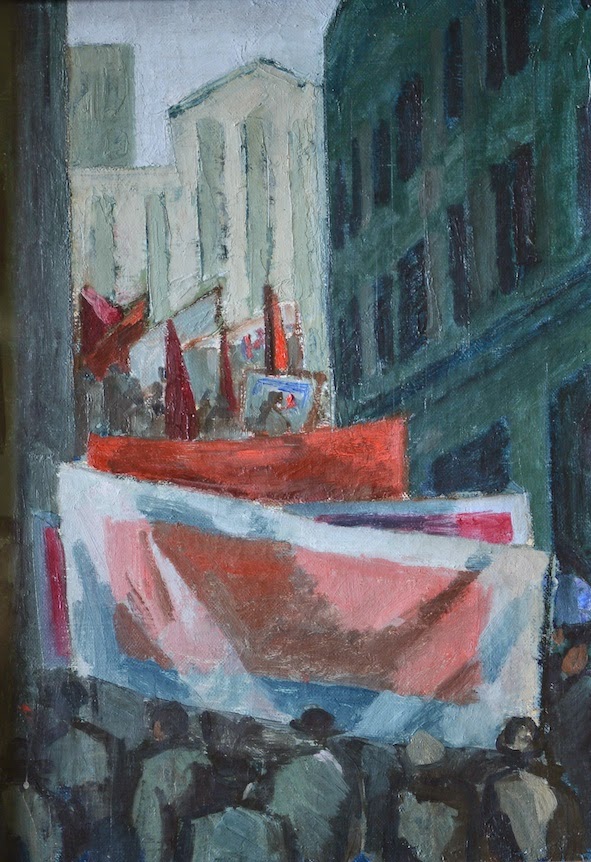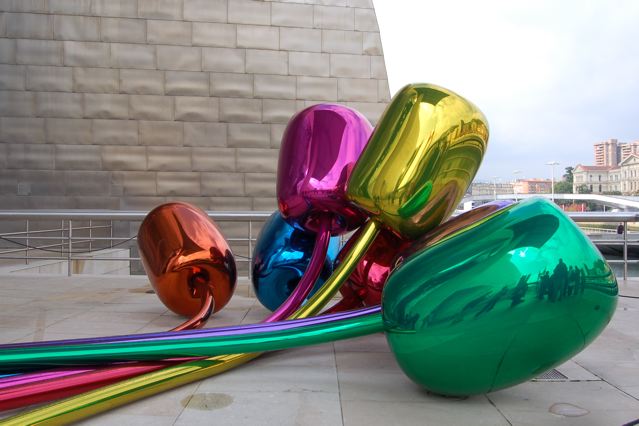If you think that provincial art galleries live in the shadow of those in major cities, think again. Pallant House Gallery in Chichester not only has some notable works of art in its permanent collection, it also stages outstanding exhibitions. Its current show, Conscience and Conflict: British Artists and the Spanish Civil War, is the first British exhibition devoted to British artists and their response to the Civil War and also examines the Spanish artists who influenced them. In this wonderful Queen Anne building, with its high ceilings and vast windows, we get space and time to see the artworks, a privilege sometimes lost in larger city galleries. We also learn about the ordinary people and the ways the Civil War affected them.
The conflict between the democratically elected Republicans and General Franco's Nationalist rebels stirred emotion across Europe. Over 2,500 recruits from Britain and Ireland joined 40,000 volunteers from 53 countries to fight in the Civil War - this was 1936-39, a precursor for the Second World War, and described by Hemingway as 'the dress rehearsal for the inevitable European War'. Romanticised by many as a 'literacy' conflict due the number of writers and poets who became involved, the war also inspired generations of artists to comment through their works of art.
Artist Felicity Browne (1904 - 36) was the first British volunteer to die in battle. A month after arriving in Spain in August 1936, she was in a party sent to blow up a munitions train when she was fatally shot under enemy fire. It is incredibly moving to see the sketchbook found on her person showing delicate drawings of her fellow volunteers and the military. Equally poignant is a wonderfully atmospheric poster by Quentin Bell, 'May Day Procession with Banner'. Red banners held aloft by protestors sway as the crowd moves up a shaded alley into a sunlit square - the light and shade is almost menacing, quiet darkness with the possibility of hope at the end of the march. But the end result was tragic for Bell - just days after he painted the poster, his brother Julian, who had volunteered as an ambulance driver, was killed in Spain.
Browne's untimely death prompted many artists to join the left-wing Artists International Association (AIA), which, since its founding in 1933, had attracted 600 diverse members, including Stanley Spencer, Barbara Hepworth, Alistair Morton, the Surrealists and the Bloomsbury Group. Through its exhibitions it raised money for the Republican cause. To get their message to a wider audience many artists moved to poster design and these are a wonderful part of the exhibition - striking, graphic and at times slightly disturbing - from Kauffer's gaunt El Greco face on a black background to the more delicate lithograph, For the Relief of Women and Children in Spain, by Frank Brangwyn, they bring home the despair of war.
The bombing of civilian targets in Spain was most chillingly felt in the Basque capital of Guernica, annihilated by Nationalists in 1937. The most famous artistic response to Guernica’s destruction was Picasso's Guernica. Now safely housed in Madrid's Reina Sofia and deemed too fragile to move, it has been recreated for this exhibition in a large textile banner created by a collective of artists since June 2013. Situated in the ground floor foyer of the gallery, it represents the passion felt by many groups, organisations and creative people about the Civil War.
Upstairs, this vibrant exhibition shows how every style and medium has been used to convey artists' messages against the Civil War. One moment we are struck by scarlet banners embroidered by British women and a menacing mask of Neville Chamberlain by surrealist F E McWilliam, and wowed by Picasso's actual Weeping Woman, - the next we are quietly humbled by a touching Hubert Finney illustration of a broken Spanish Prisoner of War, his eyes so touchingly conveying the suffering he has endured.
This is a truly informative and meticulously researched exhibition curated by Simon Martin, Artistic Director at Pallant House, and many people will be surprised at the involvement of so many British artists in the Spanish Civil War. Hence it is an important date in any art diary. After a quick visit to the many other wonderful rooms at Pallant House with their various works of art, I left feeling certainly wiser and also visually richer. I will certainly make time to visit again before the exhibition ends next month.
Conscience and Conflict: British Artists and the Spanish Civil War is at Pallant House Gallery until February 15. www.pallant.org.uk @pallantgallery Tel: 01243 774557
And a bit about... Pallant House Gallery is a unique combination of an historic Queen Anne townhouse and contemporary extension, housing one of the best collections of Modern British art in the country, including important works by Auerbach, Blake, Caulfield, Freud, Hodgkin, Nicholson, Paolozzi, Piper and Sutherland. Widely acclaimed for its innovative temporary exhibitions and exemplary Learning and Community Programme, the Gallery has won numerous awards since re–opening in 2006.
Artist Felicity Browne (1904 - 36) was the first British volunteer to die in battle. A month after arriving in Spain in August 1936, she was in a party sent to blow up a munitions train when she was fatally shot under enemy fire. It is incredibly moving to see the sketchbook found on her person showing delicate drawings of her fellow volunteers and the military. Equally poignant is a wonderfully atmospheric poster by Quentin Bell, 'May Day Procession with Banner'. Red banners held aloft by protestors sway as the crowd moves up a shaded alley into a sunlit square - the light and shade is almost menacing, quiet darkness with the possibility of hope at the end of the march. But the end result was tragic for Bell - just days after he painted the poster, his brother Julian, who had volunteered as an ambulance driver, was killed in Spain.
 |
| May Day Procession with Banner by Quentin Bell |
 |
| Kauffer's Help Wounded Human Beings |
Browne's untimely death prompted many artists to join the left-wing Artists International Association (AIA), which, since its founding in 1933, had attracted 600 diverse members, including Stanley Spencer, Barbara Hepworth, Alistair Morton, the Surrealists and the Bloomsbury Group. Through its exhibitions it raised money for the Republican cause. To get their message to a wider audience many artists moved to poster design and these are a wonderful part of the exhibition - striking, graphic and at times slightly disturbing - from Kauffer's gaunt El Greco face on a black background to the more delicate lithograph, For the Relief of Women and Children in Spain, by Frank Brangwyn, they bring home the despair of war.
The bombing of civilian targets in Spain was most chillingly felt in the Basque capital of Guernica, annihilated by Nationalists in 1937. The most famous artistic response to Guernica’s destruction was Picasso's Guernica. Now safely housed in Madrid's Reina Sofia and deemed too fragile to move, it has been recreated for this exhibition in a large textile banner created by a collective of artists since June 2013. Situated in the ground floor foyer of the gallery, it represents the passion felt by many groups, organisations and creative people about the Civil War.
Upstairs, this vibrant exhibition shows how every style and medium has been used to convey artists' messages against the Civil War. One moment we are struck by scarlet banners embroidered by British women and a menacing mask of Neville Chamberlain by surrealist F E McWilliam, and wowed by Picasso's actual Weeping Woman, - the next we are quietly humbled by a touching Hubert Finney illustration of a broken Spanish Prisoner of War, his eyes so touchingly conveying the suffering he has endured.
This is a truly informative and meticulously researched exhibition curated by Simon Martin, Artistic Director at Pallant House, and many people will be surprised at the involvement of so many British artists in the Spanish Civil War. Hence it is an important date in any art diary. After a quick visit to the many other wonderful rooms at Pallant House with their various works of art, I left feeling certainly wiser and also visually richer. I will certainly make time to visit again before the exhibition ends next month.
Conscience and Conflict: British Artists and the Spanish Civil War is at Pallant House Gallery until February 15. www.pallant.org.uk @pallantgallery Tel: 01243 774557
And a bit about... Pallant House Gallery is a unique combination of an historic Queen Anne townhouse and contemporary extension, housing one of the best collections of Modern British art in the country, including important works by Auerbach, Blake, Caulfield, Freud, Hodgkin, Nicholson, Paolozzi, Piper and Sutherland. Widely acclaimed for its innovative temporary exhibitions and exemplary Learning and Community Programme, the Gallery has won numerous awards since re–opening in 2006.

No comments:
Post a Comment